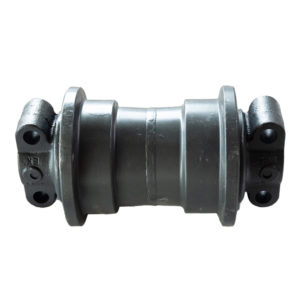The frequency of inspecting and maintaining track rollers on an excavator can depend on various factors, including the manufacturer’s recommendations, the specific working conditions, and the intensity of use. However, here is a general guideline for how often you should inspect and maintain track rollers:
- Daily or Pre-Operation Checks: Before each workday or operation, it’s a good practice to visually inspect the track rollers for any obvious damage, loose bolts, or signs of wear. Look for loose or missing nuts and bolts, as well as any visible damage to the rollers.
- Regular Routine Maintenance: In a typical scenario, routine maintenance for track rollers should be performed every 50 to 100 operating hours or weekly, depending on the excavator’s use and the manufacturer’s recommendations. This includes cleaning, lubricating, and tightening any loose components.
- In-Depth Inspections: Perform more in-depth inspections every 250 to 500 operating hours or monthly, again depending on usage and manufacturer guidelines. During these inspections, you should check for any advanced wear, cracks, or other issues with the track rollers.
- Greasing and Lubrication: Greasing the track rollers is an essential part of maintenance. The frequency of greasing can vary but is often recommended every 50 operating hours or weekly. Over-greasing can also be harmful, so follow the manufacturer’s guidelines for the right amount of grease.
- Seasonal Considerations: In extreme weather conditions or when operating in particularly harsh environments, more frequent inspections and maintenance may be required.
It’s essential to consult the excavator’s manual and follow the manufacturer’s recommendations for maintenance intervals and procedures, as they may vary between different brands and models. Additionally, always pay attention to any unusual sounds, vibrations, or changes in the excavator’s performance, as these can be early indicators of track roller issues that require immediate attention. Regular maintenance and inspection will help ensure the longevity and optimal performance of the track rollers on your excavator.
What are the signs of track roller wear and tear, and how can it be addressed?
Signs of track roller wear and tear on an excavator are crucial to detect early to prevent further damage and ensure the equipment’s safe and efficient operation. Here are some common signs of track roller wear and tear and how they can be addressed:
- Uneven Track Wear: Uneven wear on the tracks, with certain areas showing more wear than others, is a sign that the track rollers may be damaged or improperly aligned. To address this, you should inspect the rollers for damage and realign or replace them as needed.
- Excessive Noise: Unusual noises, such as grinding or squeaking sounds, while the excavator is in operation can be an indication of worn or damaged track rollers. China track rollers excavator This may require an in-depth inspection to identify the specific issue and replace the affected rollers.
- Vibration or Shaking: Vibrations or shaking during operation can be a sign of misaligned or worn track rollers. Inspect the rollers, ensure proper alignment, and replace any damaged components to resolve this issue.
- Increased Track Tension: If you notice that you need to adjust the track tension more frequently, it could be due to worn track rollers. Overly loose or overly tight tracks can cause excessive wear on the rollers and should be addressed promptly.
- Visible Damage: Visually inspect the track rollers for signs of damage, such as cracks, dents, or missing pieces. Damaged rollers should be replaced to maintain optimal performance and safety.
- Reduced Performance: A decrease in the excavator’s performance, such as slower speed or reduced maneuverability, may be indicative of track roller wear and tear. Investigate and address this issue promptly to maintain efficiency.
- Excessive Track Slippage: If you notice that the tracks slip or slide excessively, it can be due to worn or damaged track rollers. Proper inspection and replacement of damaged rollers can resolve this issue.
To address track roller wear and tear, follow these steps:
- Visual Inspection: Regularly inspect the track rollers for any visible signs of damage or wear during daily or pre-operation checks.
- In-Depth Inspection: Perform more thorough inspections during routine maintenance intervals to catch early signs of wear and tear before they become severe.
- Replace Damaged Rollers: If you identify damaged or excessively worn track rollers, replace them with new or properly refurbished ones.
- Track Alignment: Ensure that the tracks are correctly aligned to prevent uneven wear on the rollers.
- Proper Lubrication: Regularly grease and lubricate the track rollers according to the manufacturer’s recommendations to reduce friction and wear.
- Regular Maintenance: Adhere to the recommended maintenance schedule for your excavator to address wear and tear issues proactively.
By addressing track roller wear and tear promptly and performing routine maintenance, you can extend the lifespan of your equipment and maintain its efficiency and safety.
